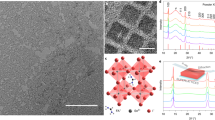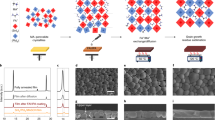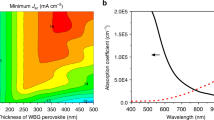Abstract
Multiple exciton generation (MEG), the generation of multiple electron–hole pairs from a single high-energy photon, can enhance the photoconversion efficiency in several technologies including photovoltaics, photon detection and solar-fuel production1,2,3,4,5,6. However, low efficiency, high photon-energy threshold and fast Auger recombination impede its practical application1,7. Here we achieve enhanced MEG with an efficiency of up to 87% and photon-energy threshold of two times the bandgap in highly stable, weakly confined formamidinium tin–lead iodide perovskite nanocrystals (FAPb1–xSnxI3 NCs; x ≤ 0.11). Importantly, an MEG-driven increment in the internal photocurrent quantum efficiency exceeding 100% with a low threshold is observed in such NC-sensitized photoconductors under ultraviolet-light illumination. The MEG enhancement mechanism is found to be mediated by the slower cooling and reduced trapping of hot carriers above the MEG threshold after the partial substitution of Pb by Sn. Our findings corroborate the potential importance of narrow-bandgap perovskite NCs for the development of optoelectronics that could benefit from MEG.
This is a preview of subscription content, access via your institution
Access options
Access Nature and 54 other Nature Portfolio journals
Get Nature+, our best-value online-access subscription
$29.99 / 30 days
cancel any time
Subscribe to this journal
Receive 12 print issues and online access
$209.00 per year
only $17.42 per issue
Buy this article
- Purchase on Springer Link
- Instant access to full article PDF
Prices may be subject to local taxes which are calculated during checkout




Similar content being viewed by others
Data availability
All data supporting the findings of this study are present in this Letter and its Supplementary Information. Additional data are available from the corresponding authors upon reasonable request.
Code availability
The codes used in this study are available from the corresponding authors upon reasonable request.
Change history
31 May 2022
In the version of this article initially published, the second affiliation omitted institutional divisions, which have now been restored to the HTML and PDF versions of the article.
References
Semonin, O. E. et al. Peak external photocurrent quantum efficiency exceeding 100% via MEG in a quantum dot solar cell. Science 334, 1530–1533 (2011).
Sambur, J. B., Novet, T. & Parkinson, B. A. Multiple exciton collection in a sensitized photovoltaic system. Science 330, 63–66 (2010).
Sukhovatkin, V., Hinds, S., Brzozowski, L. & Sargent, E. H. Colloidal quantum-dot photodetectors exploiting multiexciton generation. Science 324, 1542–1544 (2009).
Gabor, N. M., Zhong, Z. H., Bosnick, K., Park, J. & McEuen, P. L. Extremely efficient multiple electron-hole pair generation in carbon nanotube photodiodes. Science 325, 1367–1371 (2009).
Garin, M. et al. Black-silicon ultraviolet photodiodes achieve external quantum efficiency above 130%. Phys. Rev. Lett. 125, 117702 (2020).
Yan, Y. et al. Multiple exciton generation for photoelectrochemical hydrogen evolution reactions with quantum yields exceeding 100%. Nat. Energy 2, 17052 (2017).
Beard, M. C. Multiple exciton generation in semiconductor quantum dots. J. Phys. Chem. Lett. 2, 1282–1288 (2011).
Li, M. J. et al. Low threshold and efficient multiple exciton generation in halide perovskite nanocrystals. Nat. Commun. 9, 4197 (2018).
Midgett, A. G. et al. Size and composition dependent multiple exciton generation efficiency in PbS, PbSe, and PbSxSe1–x alloyed quantum dots. Nano Lett. 13, 3078–3085 (2013).
Beard, M. C. et al. Comparing multiple exciton generation in quantum dots to impact ionization in bulk semiconductors: implications for enhancement of solar energy conversion. Nano Lett. 10, 3019–3027 (2010).
Gabor, N. M. Impact excitation and electron–hole multiplication in graphene and carbon nanotubes. Accounts Chem. Res. 46, 1348–1357 (2013).
Trinh, M. T. et al. Direct generation of multiple excitons in adjacent silicon nanocrystals revealed by induced absorption. Nat. Photon. 6, 316–321 (2012).
Winzer, T., Knorr, A. & Malic, E. Carrier multiplication in graphene. Nano Lett. 10, 4839–4843 (2010).
Kim, J. H. et al. Carrier multiplication in van der Waals layered transition metal dichalcogenides. Nat. Commun. 10, 5488 (2019).
Schaller, R. D. et al. Breaking the phonon bottleneck in semiconductor nanocrystals via multiphonon emission induced by intrinsic nonadiabatic interactions. Phys. Rev. Lett. 95, 196401 (2005).
Righetto, M. et al. Hot carriers perspective on the nature of traps in perovskites. Nat. Commun. 11, 2712 (2020).
Gao, J. B., Fidler, A. F. & Klimov, V. I. Carrier multiplication detected through transient photocurrent in device-grade films of lead selenide quantum dots. Nat. Commun. 6, 8185 (2015).
Akkerman, Q. A., Raino, G., Kovalenko, M. V. & Manna, L. Genesis, challenges and opportunities for colloidal lead halide perovskite nanocrystals. Nat. Mater. 17, 394–405 (2018).
Li, M. J. et al. Slow cooling and highly efficient extraction of hot carriers in colloidal perovskite nanocrystals. Nat. Commun. 8, 14350 (2017).
Dai, L. et al. Slow carrier relaxation in tin-based perovskite nanocrystals. Nat. Photon. 15, 696–702 (2021).
de Weerd, C. et al. Efficient carrier multiplication in CsPbl3 perovskite nanocrystals. Nat. Commun. 9, 4199 (2018).
Cong, M. et al. Carrier multiplication and hot-carrier cooling dynamics in quantum-confined CsPbI3 perovskite nanocrystals. J. Phys. Chem. Lett. 11, 1921–1926 (2020).
Manzi, A. et al. Resonantly enhanced multiple exciton generation through below-band-gap multi-photon absorption in perovskite nanocrystals. Nat. Commun. 9, 1518 (2018).
Lee, J. W. et al. Formamidinium and cesium hybridization for photo- and moisture-stable perovskite solar cell. Adv. Energy Mater. 5, 1501310 (2015).
van der Stam, W. et al. Highly emissive divalent-ion-doped colloidal CsPb1–xMxBr3 perovskite nanocrystals through cation exchange. J. Am. Chem. Soc. 139, 4087–4097 (2017).
Swarnkar, A., Mir, W. J. & Nag, A. Can B-site doping or alloying improve thermal- and phase-stability of all-inorganic CsPbX3 (X = Cl, Br, I) perovskites? ACS Energy Lett. 3, 286–289 (2018).
Yan, D., Mo, Q., Zhao, S., Cai, W. & Zang, Z. Room temperature synthesis of Sn2+ doped highly luminescent CsPbBr3 quantum dots for high CRI white light-emitting diodes. Nanoscale 13, 9740–9746 (2021).
Lu, C.-H., Biesold-McGee, G. V., Liu, Y., Kang, Z. & Lin, Z. Doping and ion substitution in colloidal metal halide perovskite nanocrystals. Chem. Soc. Rev. 49, 4953–5007 (2020).
Kajal, S. et al. Unfolding the influence of metal doping on properties of CsPbI3 perovskite. Small Methods 4, 2000296 (2020).
Tiwana, P., Docampo, P., Johnston, M. B., Snaith, H. J. & Herz, L. M. Electron mobility and injection dynamics in mesoporous ZnO, SnO2, and TiO2 films used in dye-sensitized solar cells. ACS Nano 5, 5158–5166 (2011).
Wu, X. X. et al. Trap states in lead iodide perovskites. J. Am. Chem. Soc. 137, 2089–2096 (2015).
Xue, J. et al. Surface ligand management for stable FAPbI3 perovskite quantum dot solar cells. Joule 2, 1866–1878 (2018).
Protesescu, L. et al. Dismantling the ‘red wall’ of colloidal perovskites: highly luminescent formamidinium and formamidinium–cesium lead iodide nanocrystals. ACS Nano 11, 3119–3134 (2017).
Giannozzi, P. et al. QUANTUM ESPRESSO: a modular and open-source software project for quantum simulations of materials. J. Phys. Condens. Matter 21, 395502 (2009).
Li, W., Zhou, L. J., Prezhdo, O. V. & Akimov, A. V. Spin-orbit interactions greatly accelerate nonradiative dynamics in lead halide perovskites. ACS Energy Lett. 3, 2159–2166 (2018).
Yin, J. et al. Tuning hot carrier cooling dynamics by dielectric confinement in two-dimensional hybrid perovskite crystals. ACS Nano 13, 12621–12629 (2019).
Akimov, A. V. & Prezhdo, O. V. The PYXAID program for non-adiabatic molecular dynamics in condensed matter systems. J. Chem. Theory Comput. 9, 4959–4972 (2013).
Akimov, A. V. & Prezhdo, O. V. Advanced capabilities of the PYXAID program: integration schemes, decoherence effects, multiexcitonic states, and field-matter interaction. J. Chem. Theory Comput. 10, 789–804 (2014).
Tully, J. C. Molecular-dynamics with electronic-transitions. J. Chem. Phys. 93, 1061–1071 (1990).
Liu, J. & Prezhdo, O. V. Chlorine doping reduces electron-hole recombination in lead iodide perovskites: time-domain ab initio analysis. J. Phys. Chem. Lett. 6, 4463–4469 (2015).
Long, R., Liu, J. & Prezhdo, O. V. Unravelling the effects of grain boundary and chemical doping on electron-hole recombination in CH3NH3PbI3 perovskite by time-domain atomistic simulation. J. Am. Chem. Soc. 138, 3884–3890 (2016).
Long, R., Fang, W. H. & Prezhdo, O. V. Moderate humidity delays electron-hole recombination in hybrid organic-inorganic perovskites: time-domain ab initio simulations rationalize experiments. J. Phys. Chem. Lett. 7, 3215–3222 (2016).
Yin, J. et al. Modulation of broadband emissions in two-dimensional <100>-oriented Ruddlesden–Popper hybrid perovskites. ACS Energy Lett. 5, 2149–2155 (2020).
Yin, J. et al. Manipulation of hot carrier cooling dynamics in two-dimensional Dion–Jacobson hybrid perovskites via Rashba band splitting. Nat. Commun. 12, 3995 (2021).
Acknowledgements
M.L. acknowledges financial support from the Hong Kong Polytechnic University (grants 1-BE2Z, W188 and 1-ZVGH) and the Shenzhen Science, Technology and Innovation Commission (project no. R2021A064). J.Y., O.M.B. and O.F.M. acknowledge the Supercomputing Laboratory at KAUST for their efficient technical assistance.
Author information
Authors and Affiliations
Contributions
M.L. conceived the idea and designed the experiments. Y.C. performed the sample and device fabrications, characterizations and optical/electrical measurements. M.L., Y.C. and Q.W. performed the TA and TRPL measurements. C.W., X.W. and H.R. assisted in sample fabrications and characterizations. J.Y., O.M.B. and O.F.M. performed the DFT and NAMD calculations. M.L., Y.C., J.Y. and O.F.M. drafted the manuscript. S.F.Y. assisted in interpreting the results and drafting the manuscript. All the authors discussed the results and commented on the manuscript at all stages.
Corresponding authors
Ethics declarations
Competing interests
The authors declare no competing interests.
Peer review
Peer review information
Nature Photonics thanks Nathaniel Gabor, Bruce Parkinson and the other, anonymous, reviewer(s) for their contribution to the peer review of this work.
Additional information
Publisher’s note Springer Nature remains neutral with regard to jurisdictional claims in published maps and institutional affiliations.
Supplementary information
Supplementary Information
Supplementary Notes 1–3, Table 1 and Figs. 1–27.
Rights and permissions
About this article
Cite this article
Chen, Y., Yin, J., Wei, Q. et al. Multiple exciton generation in tin–lead halide perovskite nanocrystals for photocurrent quantum efficiency enhancement. Nat. Photon. 16, 485–490 (2022). https://doi.org/10.1038/s41566-022-01006-x
Received:
Accepted:
Published:
Issue Date:
DOI: https://doi.org/10.1038/s41566-022-01006-x
This article is cited by
-
Internal quantum efficiency higher than 100% achieved by combining doping and quantum effects for photocatalytic overall water splitting
Nature Energy (2023)
-
Carrier multiplication in perovskite solar cells with internal quantum efficiency exceeding 100%
Nature Communications (2023)
-
Thermalization and relaxation mediated by phonon management in tin-lead perovskites
Light: Science & Applications (2023)
-
Circular polarization-resolved ultraviolet photonic artificial synapse based on chiral perovskite
Nature Communications (2023)



